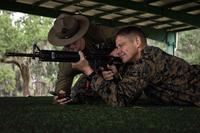A Russian Su-27 Flanker fighter jet made a dangerously close pass of a U.S. intelligence aircraft May 30 over the Black Sea, Pentagon officials announced Friday.
Army Col. Steve Warren, the chief Pentagon spokesman, said the Russian jets made two passes at the RC-135. The first pass was made in a “professional” manner in line with frequent intercepts by both countries in international airspace, Warren said, the pass by the second Flanker was “unprofessional and inappropriate.”
The second jet came from behind and flew dangerously close underneath the RC-135. “We don’t know why this intercept was conducted,” Warren said.
The disclosure of the May 30 aerial incident comes as U.S. and Russian naval officials met Wednesday for an annual meeting in Naples, Italy, to review the terms of the 1972 Prevention of Incidents On and Over the High Seas agreement, known as INCSEA.
The defense official said “the meeting did discuss recent air intercepts and encounters in the air and sea in order to review agreed upon principles encapsulated in INCSEA.” However, the official said it is not known if the May 30 aerial standoff was on the agenda.
The forum is designed to discuss ways to prevent incidents or collisions at sea between U.S. and Russian aircraft and ships. It was the first meeting of the forum since November 2013, when it was held in St. Petersburg, Russia.
The stepped-up Russian aerial harassment comes also as U.S. and NATO forces currently are conducting large-scale war games in the Baltic Sea known as Baltops 15. Three B-52 bombers from the U.S. Strategic Command were deployed to Britain for the maneuvers.
REPEAT OFFENDERS
The RC-135 intercept over the Black Sea took place around the same time as a Russian Su-24 jet interceptor buzzed the destroyer USS Ross in the Black Sea, near occupied Crimea.
Video released by the Navy June 1 shows the Russian jet making two low-level passes over the Ross as it sailed in the Black Sea.
Russian state-controlled press reports erroneously reported that the warship was forced out of the Black Sea because it was acting aggressively.
But the Navy denied the ship was pressured into leaving the area and released the video of the aerial encounter to make its point.
The May 30 encounter between the RC-135 and Su-27 is the second time the Russians have attempted to coerce or threaten U.S. reconnaissance flights over the Baltic Sea.
On April 7, a Su-27 flew dangerously close to a RC-135 flight over the Baltic Sea in what the Pentagon called “an unsafe and unprofessional manner.”
The U.S. government protested that incident in diplomatic and official channels.
The Su-27 flew within 20 feet of the RC-135 during the April 7 intercept.
As part of U.S. efforts to bolster the military forces of NATO allies in the Baltic states—Latvia, Lithuania, and Estonia—as well as Poland, the Pentagon has been increasing intelligence gathering on the movement of Russian forces in the region.
The Russian Baltic enclave of Kaliningrad is said to be a major intelligence target. Russian press reports have indicated Moscow is moving short-range Iskander nuclear-capable missiles to Kaliningrad.
The RC-135 is a militarized and upgraded Boeing 707 jetliner used in electronic and optical spying.
In addition to the dangerous aerial intercepts and the buzzing of the destroyer, Russian long-range nuclear-capable bombers have stepped up flights over Europe and North America in what military officials have said are nuclear saber-rattling by Moscow.
Adm. William Gortney, commander of the U.S. Northern Command, said in April the Russians were “messaging us” with the bomber flights.
A report by the European Leadership Network, “Dangerous Brinksmanship: Close Military Encounters Between Russia and the West in 2014,” stated that Russian fighters have increased the harassment of U.S. and NATO reconnaissance aircraft and close overflights of warships along with “mock bombing missions.”
“These events add up to a highly disturbing picture of violations of national airspace, emergency scrambles, narrowly avoided mid-air collisions, close encounters at sea, simulated attack runs, and other dangerous actions happening on a regular basis over a very wide geographical area,” the report said.
-- Richard Sisk can be reached at Richard.Sisk@military.com








